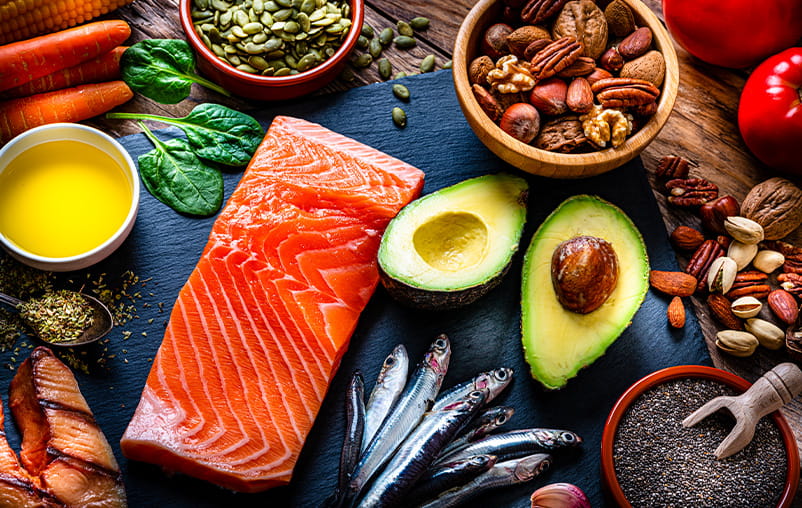Why should you eat more fruits and vegetables? Natural “plant chemicals” called phytonutrients make up the colors in fruits and vegetables and act as antioxidants. For example, carotenoids keep our eyes healthy and are found in yellow and orange foods like cantaloupes, sweet potatoes, carrots and pumpkins, as well as dark green vegetables like broccoli, spinach and kale.
A phytonutrient called lycopene is in red fruits and veggies like tomatoes, grapefruit and watermelon. Deep reddish fruits, like berries and red grapes — yes, red wine (in moderation), too — have anthocyanins. These support brain function. You can add more flavonols to your diet and support your heart health by eating more apples, dark chocolate and grapes. Leave the edible skins on fruits and vegetables to get more of these nutrients (and fiber) in your diet.
Vitamins and Minerals
Vitamins and minerals promote growth and immunity, regulate hormones and metabolism, and keep our body’s tissues and organs healthy and functioning well. They play a large role in the chemical reactions (chemistry) happening in our bodies. They don’t have calories (so they’re called micronutrients), but they are essential nutrients.
Oxidation is cell damage from oxygen by-products that can occur within our bodies. Damage to our cells can eventually cause cancer, heart disease, cataracts, diabetes, Alzheimer’s disease and other diseases. Antioxidants help to prevent oxidation and can prevent these diseases.
Antioxidants in the Foods You Eat
Vitamins A, C and E often act as antioxidants. Apricots, mangoes, red and yellow peppers are rich in Vitamin A. You probably recognize these foods have lots of beta-carotene, the orangish-yellowish pigment in foods. Vitamin C can be found many foods. You may first think of citrus fruits like limes, oranges and lemons. However, strawberries, tomatoes, cauliflower and bell peppers are also fairly high in Vitamin C. Vitamin E is carried in fats. Oils, egg yolks, nuts and seeds are a good source of this vitamin that fights to keep your heart healthy.
Cook Nutritious Meals at Home
There are several ways to preserve these helpful nutrients and avoid losing them in the cooking process. First, eat fruits and veggies raw as often as possible. The longer you cook each item, the more nutrients are destroyed.
Try to steam veggies and retain more nutrients. It’s also okay to microwave your canned vegetables to keep more nutrients (and color) in your food. You can also save cooking liquid from steaming or boiling vegetables by freezing it and use the liquid as a vegetable stock. This saves nutrients and money.
How Many Servings of Fruit and Vegetables Should I Eat?
Try to eat at least five servings of fruits and vegetables per day. You cannot eat too many vegetables. One study showed that people who ate more than eight servings of fruits and vegetables per day were 30% less likely to suffer from stroke or heart attack than those who only eat 1.5 servings or less.
Having trouble adding veggies to your meals? Here are some tips:
- Make a spaghetti sauce or burger with mushrooms or lentils in place of half of the ground meat.
- Blend cooked beans (like black beans or chickpeas) into sauces.
- Use pastas that are made from chickpeas, spinach or lentils to get more servings of vegetables in a day.
Avoid getting fruit and vegetable servings from juices and snack bars that often lose valuable nutrients and contain added sugar. Fruit juices may actually be linked to increased risk for diabetes, cardiovascular disease and cancer.
Choose Foods over Supplements
Whole fruits and vegetables have fiber, which helps with regularity and lowering cholesterol levels. Fiber-rich foods also tend to be lower in fat and calories. At the same time, fiber helps you to feel fuller and limit the total amount of calories you eat per day. This can help with maintaining your weight.
When you choose supplements, you don’t actually know how much of the nutrient you will absorb because it isn’t in its natural form. You can consume too little or too much of a vitamin. This danger does not usually occur when eating a balanced diet.
There is no research to support that taking antioxidant supplements prevents disease. In fact, doing so may put you at risk for some pretty unpleasant side effects.
It’s thought that people who take supplements already eat generally healthy diets and lead an overall healthier lifestyle. It’s not actually the supplements keeping them healthy, but the way that they prioritize their health altogether.
But fruits and vegetables are carbs
There’s a lot of talk going around that “carbs” are bad for us. This is mainly meant to highlight that we should avoid candies, sweets, refined/low-fiber starches, such as white breads and pastas, and sugary beverages. But we don’t give enough praise and attention to the “good carbs”— fruits, vegetables and fiber-rich grains.
Studies have shown that people who eat “low-carb” and limit their fruit and vegetable intake are more likely to develop or worsen the risk for heart disease, diabetes or stroke or even to die from these diseases. Nine out of ten Americans already don’t eat enough fruits and vegetables.
If you’re worried about blood sugar levels, remember that vegetables are mostly fiber and water and only minimally raise your blood sugars if at all. While carbohydrates from fruit raises your blood sugar level, you also get plenty of benefits from the fiber and overall nutrient content that makes choosing fruits and vegetables over starches and simple sugars a worthwhile choice.
Incorporating more fresh fruits and vegetables into your meals and snacks every day not only will make your plate more colorful, but it also can improve your health. You can even make it a game: Try to eat each color of the rainbow every day!
Sources
- ADA Complete Food and Nutrition Guide, 4th Edition. Roberta Larson Duyff. Chapter 14. Chapter 6.
- https://www.hsph.harvard.edu/nutritionsource/what-should-you-eat/vegetables-and-fruits/
- https://www.pcrm.org/good-nutrition/nutrition-programs-policies/2020-2025-dietary-guidelines
- Only 1 in 10 Adults Get Enough Fruits or Vegetables | CDC Online Newsroom | CDC
- Micha R, Peñalvo JL, Cudhea F, Imamura F, Rehm CD, Mozaffarian D. Association Between Dietary Factors and Mortality From Heart Disease, Stroke, and Type 2 Diabetes in the United States. JAMA. 2017;317(9):912–924. doi:10.1001/jama.2017.0947
- Hung HC, Joshipura KJ, Jiang R, Hu FB, Hunter D, Smith-Warner SA, Colditz GA, Rosner B, Spiegelman D, Willett WC. Fruit and vegetable intake and risk of major chronic disease. Journal of the National Cancer Institute. 2004 Nov 3;96(21):1577-84.
- Muraki I, Imamura F, Manson JE, Hu FB, Willett WC, van Dam RM, Sun Q. Fruit consumption and risk of type 2 diabetes: results from three prospective longitudinal cohort studies. BMJ. 2013 Aug 29;347:f5001.
- Bazzano LA, Li TY, Joshipura KJ, Hu FB. Intake of fruit, vegetables, and fruit juices and risk of diabetes in women. Diabetes Care. 2008 Apr 3.




